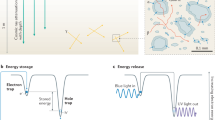Abstract
Chondritic meteorites are widely regarded as a unique source of information on the chemical and physical processes that occurred in the early Solar System. An important phase in their history is a period of metamorphism1 and thermoluminescence (TL) has proved a powerful technique for exploring this aspect, especially at the low end of the metamorphic spectrum2. The ordinary chondrites as a whole display a 105-fold range in TL sensitivity, while the least metamorphosed, or type 3, ordinary chondrites display a 103-fold range. Associated with this 103-fold range in TL sensitivity are variations in the temperature at which the maximum TL emission occurs, and in the temperature range over which emission occurs3,4. We report here the results of annealing experiments on a little-metamorphosed (type 3.5) ordinary chondrite. The TL emission characteristics of the annealed samples show trends very similar to those observed in meteorites which have naturally been metamorphosed to various extents. The trends are also similar to those observed in annealing experiments on terrestrial albite5–7 where the changes are associated with the low-to high-temperature transformation. These data suggest that the TL phosphor in meteorites is feldspar and that TL can be used to estimate palaeotemperatures for little-metamorphosed and highly-unequilibrated meteorites.
This is a preview of subscription content, access via your institution
Access options
Subscribe to this journal
Receive 51 print issues and online access
$199.00 per year
only $3.90 per issue
Buy this article
- Purchase on Springer Link
- Instant access to full article PDF
Prices may be subject to local taxes which are calculated during checkout
Similar content being viewed by others
References
Dodd, R. T. Geochim. cosmochim. Acta 33, 161–203 (1969).
Sears, D. W., Grossman, J. N., Melcher, C. L., Ross, L. M. & Mills, A. A. Nature 287, 791–795 (1980).
Sears, D. W., Grossman, J. N. & Melcher, C. L. Geochim. cosmochim. Acta 46, 2471–2481 (1982).
Sears, D. W. G. & Weeks, K. S. J. geophys. Res. Suppl. 88, B301–B311 (1983).
Pasternak, E. S. thesis, Univ. Pennsylvania (1978).
Pasternak, E. S., Gains, A. M. & Levy, P. W. Geol. Soc. Am. Abstr. with Program 8, 1044 (1976).
Levy, P. W. PACT J. 3, 466–480 (1978).
Smith, J. V. J. Geol. 80, 505–525 (1972).
Lalou, C., Nordmann, D. & Labyrie, J. C. r. hebd. Séanc. Acad. Sci., Paris D 270, 2401–2404 (1970).
Dodd, R. T. Meteorites (Cambridge University Press, 1981).
Onuma, N., Clayton, R. N. & Mayeda, T. K. Geochim. cosmochim. Acta 36, 157–168 (1972).
Mayeda, T. K., Clayton, R. N. & Olsen, E. J. Meteoritics 15, 330–331 (1980).
Author information
Authors and Affiliations
Rights and permissions
About this article
Cite this article
Guimon, R., Weeks, K., Keck, B. et al. Thermoluminescence as a palaeothermometer. Nature 311, 363–365 (1984). https://doi.org/10.1038/311363a0
Received:
Accepted:
Issue Date:
DOI: https://doi.org/10.1038/311363a0
This article is cited by
-
Thermoluminescence Studies of β and γ-Irradiated Geological Materials for Environment Monitoring
Journal of Fluorescence (2020)
-
Thermoluminescence and fission track impact features of rocks
Chinese Science Bulletin (2000)
-
Metamorphism of eucrite meteorites studied quantitatively using induced thermoluminescence
Nature (1991)
-
The type three ordinary chondrities: A review
Surveys in Geophysics (1987)
Comments
By submitting a comment you agree to abide by our Terms and Community Guidelines. If you find something abusive or that does not comply with our terms or guidelines please flag it as inappropriate.



